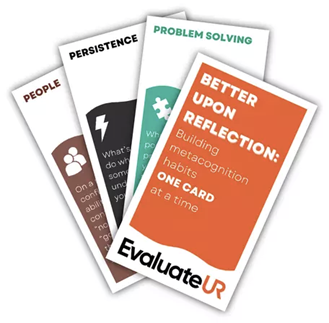| by Dana Melone, Cedar Rapids Kennedy High School |
Downloadable |
Motivation and Context:
I teach AP Psychology at a Kennedy High School in Cedar Rapids, Iowa. My students range in age from 15-18 years old. They also come into my classroom with a variety of grade point averages ranging from below a 2.0 to above a 4.0. While some students have excellent, note taking and study skills as well an understanding of what they need to study, I find that most of my students (even the top ones) tend to try to study everything and get overwhelmed. They also do not utilize review time to their advantage.
At the same time my students love review games and in class review time. However, for years I was hesitant to play them or give them time to review in class because they would be so actively engaged in the game or review activity that they would not take the time to consider what they knew and what they did not know, and how this should effect their studying (i.e. practice metacognition about their learning). I wanted to engage them in demonstrations and games but I also wanted them to use those activities to guide their studying and develop effective learning strategies that could be used beyond my course. In response to this dilemma, I developed the metacognitive prompt chart below.
Nuts and Bolts:
In order to help students gauge how much they know, I have started requiring them to complete the metacognitive chart as they are reviewing in class or playing a review game I have also pointed out that they can use the chart even when they are working on current content. The chart consists of 4 columns that help students categorize their understanding of the concepts.
Students use the chart by putting the concept names in the column that best describes their understanding of each concept as we move through review activities or games. There are also two questions at the bottom that ask them about the focus of their studying and patterns they have seen over time. In the end, they have a chart that allows them in one glance to know what they need to study and what they have knowledge of.
- What concepts need to be the focus of your studying? How will you make sure you are studying them actively?
- Look at your past charts, what concepts seem to remain a problem? How will you address this?
My students have this chart out any time we are going over previously learned content or reviewing (multiple times a week). I encourage my students to re-examine their charts once a week to look for patterns over time and reflect on what they need to get help with or review. I also encourage them to combine any charts as we near assessments that are cumulative. Multiple times a month I collect the sheets and can visibly see areas that all my students are struggling. I have been able to use it for my own personal metacognition in planning review, re-teaching, and remediation times.
Outcomes:
This chart has proven its effectiveness on many levels. Students have been able to visibly see the areas that they need improvement in and should focus on. They are also able to examine these sheets over time to see patterns in the content that they are struggling with and doing well with. An unintended outcome has been the ability to use it as the teacher for ongoing formative assessment of my classes.




